Antlia is a small, faint constellation located in the southern skies. Its name is an ancient Greek word for “the pump.” The constellation was originally named Antlia Pneumatica, to commemorate the invention of the air pump, which it represents.
Antlia was created and catalogued by the French astronomer Abbé Nicolas Louis de Lacaille in the 18th century, along with 13 other constellations introduced by Lacaille to fill the void in some faint regions in the southern sky. Lacaille’s constellations are mostly named after scientific instruments and there are no myths attached to them.
Notable deep sky objects in Antlia include the Antlia Dwarf Galaxy, the Antlia Cluster of Galaxies, the spiral galaxies NGC 3244 and IC 2560, the unbarred spiral NGC 2997, and the interacting pair IC 2545. Members of the Antlia Cluster include the massive elliptical galaxies NGC 3258 and NGC 3268, the elliptical galaxy NGC 3260, the lenticular galaxies NGC 3269 and NGC 3267, the spiral galaxy NGC 3281, and the barred spiral NGC 3271, the brightest spiral galaxy in the cluster.
Facts, location and map
Antlia is one of the smaller constellations in the sky (62nd in size), occupying an area of 239 square degrees. It is located in the second quadrant of the southern hemisphere (SQ2) and can be seen at latitudes between +45° and -90°. The neighboring constellations are Centaurus, Hydra, Pyxis, and Vela.
The constellation name Antlia is pronounced /ˈæntliə/. In English, the constellation is known as the Air Pump. The genitive form of Antlia, used in star names, is Antliae (pronunciation: /ˈæntliiː/). The three-letter abbreviation, adopted by the International Astronomical Union (IAU) in 1922, is Ant.
Antlia does not have any stars brighter than magnitude 3.00. It contains two stars located within 10 parsecs (32.6 light years) of Earth.
The brightest star in Antlia is Alpha Antliae. The nearest star in Antlia, DEN 1048−3956, is a brown dwarf only 13.15 light years distant from Earth. Antlia has two stars with known planets, HD 93083 (spectral class K2V) and WASP-66 (F4V). There are no meteor showers associated with Antlia. The constellation does not contain any Messier objects.
Antlia contains one formally named star. The star name approved by the International Astronomical Union (IAU) is Macondo (HD 93083).
Antlia belongs to the Lacaille family of constellations, along with Caelum, Circinus, Fornax, Horologium, Mensa, Microscopium, Norma, Octans, Pictor, Reticulum, Sculptor, and Telescopium.
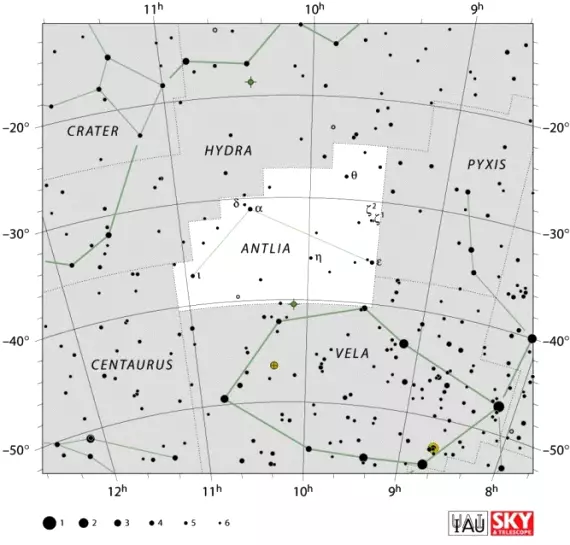
Antlia constellation map, by IAU and Sky&Telescope magazine
Antlia story
Antlia does not have a myth associated with it. It was named after the air pump, Antlia pneumatica, an instrument invented by the French physicist Denis Papin, who is also famous for inventing the steam digester, which preceded the steam engine and the pressure cooker.
As depicted by Lacaille, Antlia represents the single-cylinder pump that Papin used in his experiments in the 1670s.
The constellation Antlia was first catalogued in Lacaille’s Coelum Australe Stelliferum, published posthumously in 1763. The catalogue included almost 10,000 southern stars, 42 nebulous objects, and 14 new constellations, now known as the Lacaille family.
Major stars in Antlia
α Antliae (Alpha Antliae)
Alpha Antliae is the brightest star in the constellation, but it is only a fourth magnitude star. Its apparent magnitude varies between 4.22 and 4.29. It is located approximately 365 light years away.
Alpha Antliae is classified as a K-type giant. Its age is estimated to be about a billion years, so the next evolutionary stage it will reach is Mira-type variable before it turns into a white dwarf.
Other notable stars:
ε Antliae (Epsilon Antliae) is an orange K-type giant, approximately 700 light years distant. It has an apparent magnitude of 4.51.
ι Antliae (Iota Antliae) is an orange K-type giant approximately 199 light years distant. It has an apparent magnitude of 4.60.
θ Antliae (Theta Antliae, IDS 09397-2719 B) is a binary star, approximately 384 light years away. It consists of Theta Antliae A, a white A-type main sequence dwarf, and Theta Antliae B, a yellow-white F-type bright giant. Theta Antliae has an apparent magnitude of 4.78.
η Antliae (Eta Antliae) is also a binary star. It is 106 light years distant. The brighter component is a yellow-white F-type giant with an apparent magnitude of 5.2. The companion star is faint, with a magnitude of 11.3. It is located 31 arc seconds away.
U Antliae is a red C-type carbon star, approximately 836 light years distant. It is classified as an irregular variable star. It has an apparent magnitude of 5.5 and its brightness varies by 1.6 magnitudes.
AG Antliae (HD 89353) is notable for being a post-asymptotic giant branch star. Post-AGB stars are important sources of dust enrichment. AG Antliae has an apparent magnitude of 5.53 and is more than 2000 light years distant.
δ Antliae (Delta Antliae) is another double star, approximately 481 light-years away. The brighter component has an apparent magnitude of +5.57 and is classified as a blue-white B-type main sequence dwarf. The fainter star is a visual companion 11 lying arc seconds away.
Deep sky objects in Antlia
Antlia Dwarf (PGC 29194)
The Antlia Dwarf, sometimes also referred to as the Antlia Dwarf Galaxy, is a dwarf spheroidal galaxy located about 4.3 million light years from Earth. It is a very faint object, with an apparent magnitude of 16.2. The galaxy was not discovered until 1997.
The Antlia Dwarf lies on the outer rim of the Local Group of galaxies, possibly even beyond it, and there is evidence suggesting that it is tidally interacting with another small galaxy, NGC 3109, in the Hydra constellation.
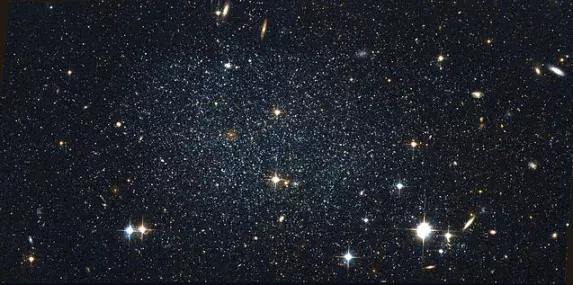
Antlia Dwarf, image NASA/ESA
NGC 2997 (ESO 434- G 35, PGC 27978)
NGC 2997 is an unbarred spiral galaxy in Antlia, located approximately 24.8 million light years away. It is a grand design galaxy, which is to say the kind of spiral galaxy with clearly defined spiral arms that extend around it. Only ten percent of spiral galaxies are grand design spirals.
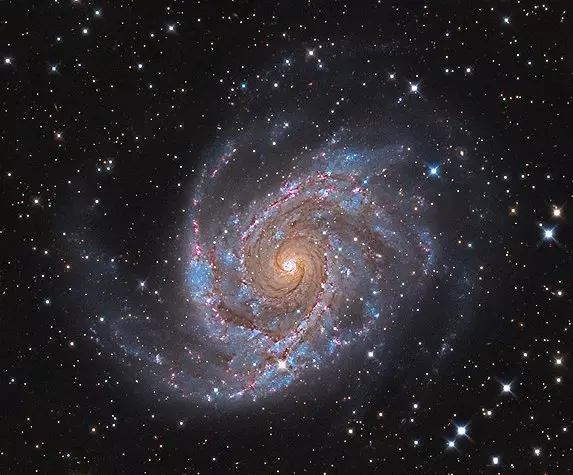
NGC 2997, image: Adam Block/ChileScope (CC BY-SA 4.0)
What makes NGC 2997 particularly notable is the chain of hot giant clouds of ionized hydrogen surrounding the galaxy’s nucleus.
NGC 2997 is the brightest galaxy in the NGC 2997 group, a group of galaxies, approximately 24.8 million light-years distant, belonging to the Local Supercluster.
Antlia Cluster (Abell S0636)
The Antlia Cluster is a cluster of galaxies within the Hydra–Centaurus Supercluster which, in turn, is the closest neighbour to the Virgo Supercluster, in which the Milky Way Galaxy is located.
The cluster is the third closest to our Local Group, with only the Fornax Cluster and Virgo Cluster lying closer. The Antlia Cluster does not have a single brightest cluster galaxy and is therefore classified as a Bautz-Morgan type III cluster, which is a rather rare type of galaxy cluster.
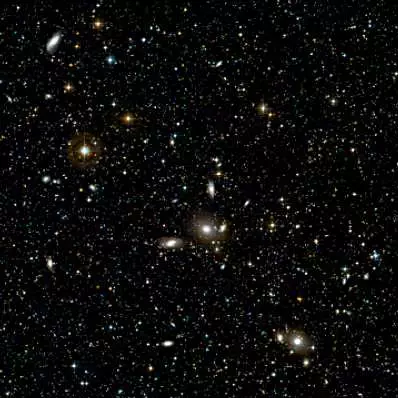
Antlia Cluster, image: Atlas of the Universe (CC BY-SA 3.0)
The Antlia Cluster contains about 234 galaxies and is dominated by two massive elliptical galaxies, NGC 3258 and NGC 3268.
The northern subgroup of galaxies inside the cluster gravitates around NGC 3268, while the southern subgroup is centered on NGC 3258. Each of the two giant elliptical galaxies contains several thousand globular clusters.
Most galaxies in the Antlia Cluster are early type galaxies, and dwarf elliptical galaxies are the most common galaxy type.
The Antlia Cluster is located between 32.58 and 32.71 million light years from Earth. In spite of being relatively close by, it has not been sufficiently investigated.
IC 2560
IC 2560 is another spiral galaxy in Antlia. It has an apparent magnitude of 13.31 and lies at an approximate distance of 110 million light years from Earth. The galaxy occupies an area 2.79’ x 1.06’ in size.
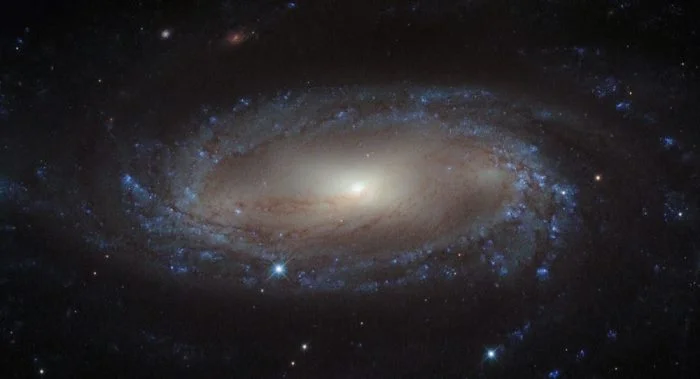
Lying more than 110 million light-years away from Earth in the constellation of Antlia (The Air Pump) is the spiral galaxy IC 2560, shown here in an image from NASA/ESA Hubble Space Telescope. At this distance it is a relatively nearby spiral galaxy, and is part of the Antlia cluster — a group of over 200 galaxies held together by gravity. This cluster is unusual; unlike most other galaxy clusters, it appears to have no dominant galaxy within it. In this image, it is easy to spot IC 2560’s spiral arms and barred structure. This spiral is what astronomers call a Seyfert-2 galaxy, a kind of spiral galaxy characterized by an exceptionally bright nucleus and very strong emission lines from certain elements — hydrogen, helium, nitrogen, and oxygen. The bright center of the galaxy is thought to be caused by the ejection of huge amounts of super-hot gas from the region around a central black hole. There is a story behind the naming of this quirky constellation — Antlia was originally named antlia pneumatica by French astronomer Abbé Nicolas Louis de Lacaille, in honor of the invention of the air pump in the 17th century.
Image: Hubble/European Space Agency and NASA
IC 2545
IC 2545 is a pair of interacting galaxies located at a distance of 450 million light years from Earth. The galaxies have a visual magnitude of 14.27 and an apparent size of 0.6’ x 0.4’. They were discovered by the American astronomer DeLisle Stewart on May 1, 1900.
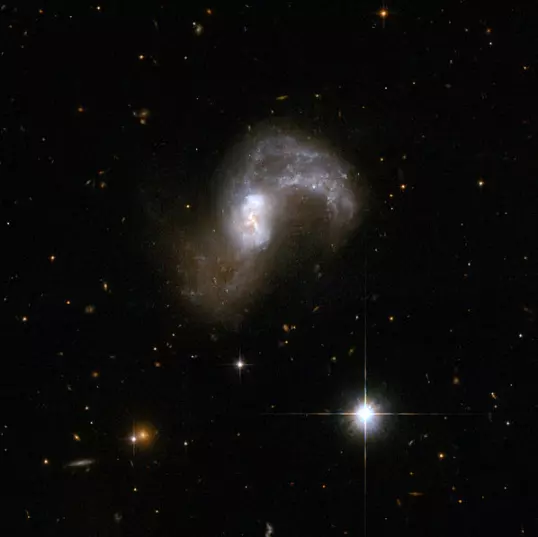
IC 2545 is a beautiful, but deceptive object that appears to be a single S-shaped galaxy, but is actually a pair of merging galaxies. The two cores of the parent galaxies are still visible in the central region. Other telltale markers for the collision include two pronounced tidal arms of gas and stars flung out from the central region. The tidal arm curving upwards and clockwise in the image contains a number of blue star clusters. IC 2545 glows strongly in the infrared part of the spectrum – another sign that it is a pair of merging galaxies. It lies in the constellation of Antlia, the Air Pump, some 450 million light-years away from Earth. This image is part of a large collection of 59 images of merging galaxies taken by the Hubble Space Telescope and released on the occasion of its 18th anniversary on 24th April 2008. Image: NASA, ESA, the Hubble Heritage (STScI/AURA)-ESA/Hubble Collaboration, and A. Evans (University of Virginia, Charlottesville/NRAO/Stony Brook University)
NGC 3125
NGC 3125 is a starburst galaxy with an apparent magnitude of 12.4, located at a distance of about 50 million light years from Earth. The galaxy has an apparent size of 1.5′ x 0.8′. It was discovered by John Herschel on March 30, 1835.
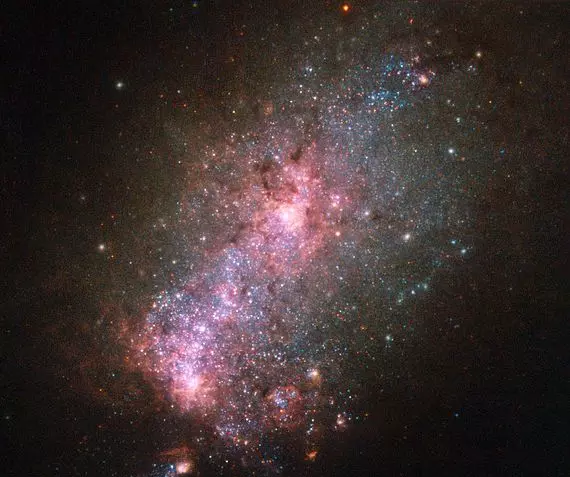
This NASA/ESA Hubble Space Telescope image reveals the vibrant core of the galaxy NGC 3125. Discovered by John Herschel in 1835, NGC 3125 is a great example of a starburst galaxy — a galaxy in which unusually high numbers of new stars are forming, springing to life within intensely hot clouds of gas. Located approximately 50 million light-years away in the constellation of Antlia (The Air Pump), NGC 3125 is similar to, but unfathomably brighter and more energetic than, one of the Magellanic Clouds. Spanning 15 000 light-years, the galaxy displays massive and violent bursts of star formation, as shown by the hot, young, and blue stars scattered throughout the galaxy’s rose-tinted core. Some of these clumps of stars are notable — one of the most extreme Wolf–Rayet star clusters in the local Universe, NGC 3125-A1, resides within NGC 3125. Despite their appearance, the fuzzy white blobs dotted around the edge of this galaxy are not stars, but globular clusters. Found within a galaxy’s halo, globular clusters are ancient collections of hundreds of thousands of stars. They orbit around galactic centres like satellites — the Milky Way, for example, hosts over 150 of them. Image: ESA/Hubble & NASA Acknowledgement: Judy Schmidt
NGC 3244
NGC 3244 is a spiral galaxy about 100 million light years distant. It has a visual magnitude of 12.89 and an apparent size of 2’ x 1.5’. The galaxy was discovered by John Herschel on April 22, 1835.
On June 2010, a supernova was discovered in NGC 3244. Designated SN 2010ev, it reached a magnitude of about 14 and was the third brightest supernova discovered that year.
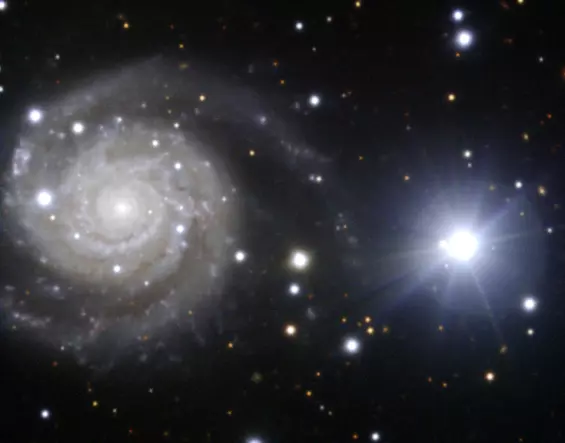
This new image of the spiral galaxy NGC 3244 was taken with the help of the President of the Czech Republic, Václav Klaus, during his visit to ESO’s Paranal Observatory [1], on the night of 6 April 2011. The Czech Republic joined ESO in 2007, and this was the first visit of the country’s President to an ESO site. This galaxy has attracted considerable interest from astronomers over the past nine months, thanks to the violent death of one of its stars, which was discovered on 27 June 2010. This supernova explosion, now known as Supernova 2010ev (SN 2010ev), is still visible as the — now faint — blue dot nestled within one of the thick spiral arms just to the left of the galaxy’s nucleus.
To the right of the galaxy, an unremarkable foreground star in our own Milky Way, TYC 7713-527-1, shines brightly enough to catch our attention. Although the star seems a great deal brighter than SN 2010ev, this is actually an illusion created by the large difference in the distances of the two objects. The galaxy is much further away, at a distance of about 90 million light years, while the star lies thousands of times closer, within our own galaxy. At its brightest, SN 2010ev reached an apparent magnitude of about 14, making it about 1000 times dimmer than the naked eye can see, but it was still the third brightest supernova observed in 2010. In fact, if the supernova had been as close to Earth as TYC 7713-527-1, it would have been easily visible to the naked eye, unlike the aforementioned star. The image was taken using the FORS2 instrument on the ESO Very Large Telescope (VLT). The filters used for the image were B, V and R, which were coloured blue, green and red respectively. A framed print of the President’s Galaxy has been presented to Václav Klaus, as a memento of his visit to Paranal. Image: ESO